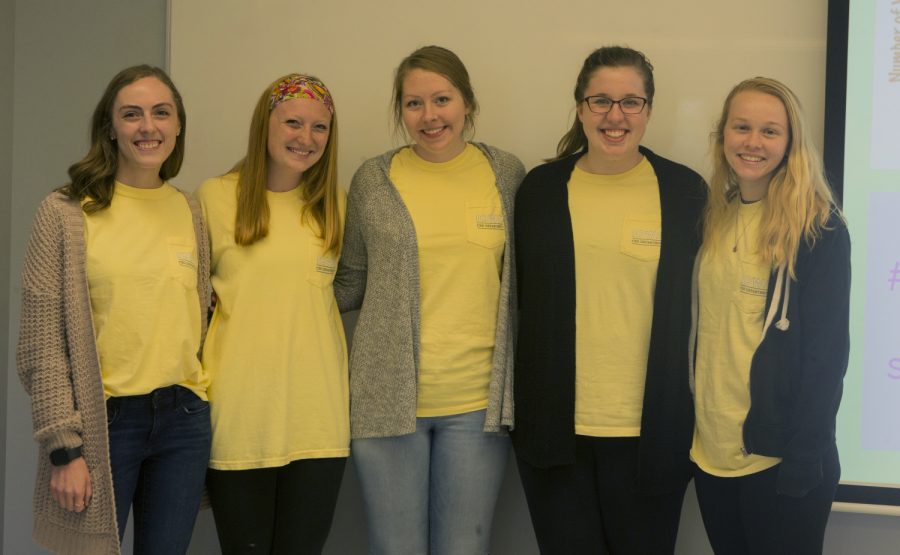First words to full sentences: the UI’s top ranked communication program
The UI’s Department of Communication Sciences and Disorders provides graduate students with hands-on experiences to engage in early childhood development in classroom settings.
University of Iowa students Audrey Wood, Kenzie Busch, Jordyn Meyer, Paige Kehrli, and Samantha Reed pose for a group photo next to a presentation used for the birth to five course in the Wendell Johnson Speech and Hearing Clinic on Monday, May 6, 2019.
May 6, 2019
The University of Iowa Department of Communication Sciences and Disorders is ranked as one of the top programs in the country consistently by US News & World Reports. And its success lies in the hands-on opportunities for students.
Clinical Associate Professor Anu Subramanian, the director of clinical education, said one of the key opportunities graduate students are involved with the program is through course work, including a class called Language Disorders in Children: Birth to 5, which involves early classroom collaboration.
“It started off as a project with collaboration in the Neighborhood Centers of Johnson County to work with teachers in the centers to give them language strategies,” Subramanian said.
RELATED: Two UI friends launch app that helps improve public-speaking skills
Neighborhood Centers Child Care Director Jana Garrelts said the program has brought a lot of focus on language acquisition in classrooms.
“It allows us to have an individual focus on kids who may need a little bit more attention,” she said. “They see the teachers over a few times in the semester, which gives the teachers valuable professional development and skills so they can continue to build language for the child throughout the year.”
Subramanian stressed a few key purposes behind the structure of the program.
“The goal of early intervention is that you coach parents,” Subramanian said. “You put them in natural environments. It does not just mean go to your own home, but also use toys and activities that are already a part of the culture of the family and incorporate language into that.”
The program takes into account peer institutions in which they have written various accounts on the Teach-Model-Coach-Review methodology from Assistant Professor Megan Roberts of Northwestern University.
“At the Neighborhood Centers, we use that same methodology where we first teach an hour and a half in-service with the teachers and aides about topics that they are interested in,” Subramanian said. “The centers have mostly bilingual kids, so these topics can include bilingualism, language stipulation strategies, or routines.”
Upon finishing the Teach element, the Neighborhood Centers assigns three or four classrooms to get involved and allows teachers to choose a few children they have concerns with about language for the Model stage, Subramanian said.
“UI students are able to physically go to these classrooms and observe and interact with kids and see what kinds of concerns there are,” Subramanian said.
Following the Model portion, students are able to follow up with teachers and give them ideas, Subramanian said.
“The neighborhood centers are great because the aides are usually similar cultures where the children are from,” Subramanian said. “They work with whoever wants to be coached to try to incorporate these ideas into their daily routines.”
The last part is Review, Subramanian said, in which everyone talks about the experience.
The program takes students to 3- and 4-year-old classrooms and identifies kids who are having issues with speaking, Subramanian said.
“It gives the students an opportunity to work with bilingual kids, kids of low socioeconomic status, and different backgrounds that we don’t often see in our department clinic,” Subramanian said.
UI graduate student in speech pathology Benjamin Kost has taken a variety of courses and clinical experiences.
“We work on different teams with varieties of populations,” he said. “I think the hands-on experience is absolutely valuable. We learn a lot in our academic courses and theories behind language development, but really — the most important part is being able to go into the Neighborhood Center and getting hands-on experience with these populations.”






